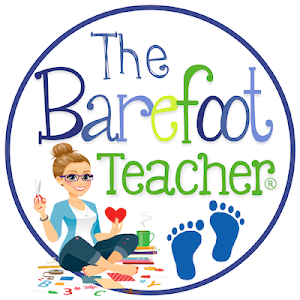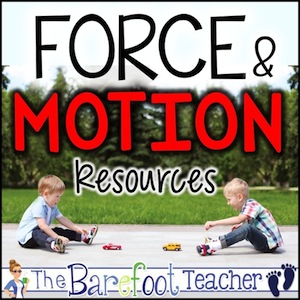(Not familiar with the NGSS standards?
Then take some time to read "Getting to Know the Next Generation Science Standards: Kindergarten" first.)
Today we're going to talk about moving and grooving with your littles as you explore Force & Motion! I'm going to share a variety of activities and resources that you can use in your classroom that will keep even the squirreliest of your kids both intrigued and engaged.
To start off, it's important that your students know ahead of time what will be expected of them during this unit.
Here is a FREE poster set (choose Kindergarten or First Grade) that you can download, printout, laminate, and hang up around your classroom for your science lessons.
It goes along with the performance expectations of the NGSS.
There are three different styles you can choose from: Chalkboard, Polka Dot, or Less-Ink Option.
Kindergarten NGSS "I CAN" Posters*
First Grade NGSS "I CAN" Posters*
Now that you have that download, let's dive into some resources!
I'd like to first share what I have used and found to be most successful in helping my littles not only understand the concept of Force & Motion, but master it as well.
This is a Motion & Stability: Forces & Interactions Interactive Notebook.
(There is an Interactive Notebook section for each of the NGSS concepts taught so that you can collect them all in one composition notebook...a perfect way for students to review and reflect on past lessons learned!)
To start off, it's important that your students know ahead of time what will be expected of them during this unit.
Here is a FREE poster set (choose Kindergarten or First Grade) that you can download, printout, laminate, and hang up around your classroom for your science lessons.
It goes along with the performance expectations of the NGSS.
There are three different styles you can choose from: Chalkboard, Polka Dot, or Less-Ink Option.
Kindergarten NGSS "I CAN" Posters*
First Grade NGSS "I CAN" Posters*
Now that you have that download, let's dive into some resources!
I'd like to first share what I have used and found to be most successful in helping my littles not only understand the concept of Force & Motion, but master it as well.
This is a Motion & Stability: Forces & Interactions Interactive Notebook.
(There is an Interactive Notebook section for each of the NGSS concepts taught so that you can collect them all in one composition notebook...a perfect way for students to review and reflect on past lessons learned!)
 It comes with a set of corresponding Force & Motion Vocabulary posters to hang around your room. The posters break down the vocab as simply as possible so that even five years olds can understand what each term means. I remember the first time I learned that I had to teach Force & Motion to my Kindergarten class. I myself hadn't learned it until I was in high school...how was I supposed to help little kids understand it?! Anybody else feel that way? I had to really sit down and think about the fact that kids use force and motion every single day. Why wouldn't we teach them about it?
It comes with a set of corresponding Force & Motion Vocabulary posters to hang around your room. The posters break down the vocab as simply as possible so that even five years olds can understand what each term means. I remember the first time I learned that I had to teach Force & Motion to my Kindergarten class. I myself hadn't learned it until I was in high school...how was I supposed to help little kids understand it?! Anybody else feel that way? I had to really sit down and think about the fact that kids use force and motion every single day. Why wouldn't we teach them about it?Here are the posters that come with the Force & Motion set:
It includes an interactive notebook cover so that your students can separate and organize all of the science concepts you cover throughout the year.
The next page is the vocabulary reinforcer:
This Pocket full of Vocab matches the poster set (shown up above earlier). Have students pull the cards out of the pocket and review the meanings of the terms. They can quiz themselves, quiz a neighbor, and even write short definitions on the back to help them remember.
The next page has students simply determining which object are pushed and which are pulled...
...to get them thinking about how forces are involved in their daily interactions with the world around them. Give them some opportunities to walk around the classroom or playground and observe how they push and pull various objects.
Also, take some different sports balls and bounce them around. Talk about direction and motion. How can they change the direction or movement of the balls?
I've noticed that kids LOVE to prove how smart they are. So this page that not only reinforces your class discussions on Force & Motion, but also give the kids a chance to feel smart, quiz their friends, and practice what they've learned.

Students simply pull out one of the many questions and either answer the questions or do what it says.
A bowling investigation is included, too!
Can a bowling ball knock over pins without being touched by a person? Grab a soft ball and stack up some plastic cups and find out!
First, have the students predict the answer to the investigation question. Then have them survey the class, tally up the votes, and graph out the results of the survey.
Next, get experimenting! What happens if you blow on the "bowling" ball with your mouth? Does it move? Does it knock over any pins? What if you blow through a straw? Can you roll another ball into it? Place it on a ramp?
Which way knocked over the most pins? Or which way was most effective in knocking over the pins? Lift up the bowling pins and draw a picture of what worked best!
That includes all of the Interactive Notebook components.
But you may want even more Force & Motion activities for your class!
Try this additional Force & Motion Activities Pack.
It includes a Flip Book, Emergent Readers, Sorts, and also has the same Bowling Investigation & Vocab Poster Set that the Interactive Notebook has.
It includes a Flip Book, Emergent Readers, Sorts, and also has the same Bowling Investigation & Vocab Poster Set that the Interactive Notebook has.
Have fun moving and grooving!
-Til next time
*Next Generation Science Standards (NGSS) is a registered trademark of Achieve. Neither Achieve nor the lead states and partners that developed the Next Generation Science Standards was involved in the production of, and does not endorse, the above resources mentioned.






























































